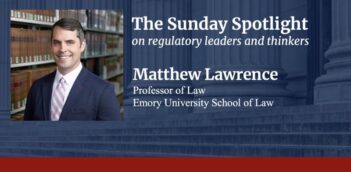
Scholars argue the battle against spam calls holds valuable lessons for Big Tech regulators.
Nearly two decades ago, the Federal Trade Commission (FTC) created the National Do Not Call Registry. Today, the list contains almost 245 million phone numbers.
In a new article, two legal experts argue that the FTC’s actions in creating its do-not-call list carry helpful lessons for those who advocate regulating “Big Tech” firms such as Amazon, Apple, Google, and Facebook.
The scholars, William Kovacic of the George Washington University Law School and David Hyman of Georgetown Law explain that the FTC’s success with the National Do Not Call Registry hinged on learning from past mistakes, collaborating with other agencies, and adapting in a swift manner as new challenges arose. They argue that these are all skills that regulators should seek to emulate in future regulations of Big Tech.
Kovacic and Hyman, who were both high-ranking attorneys at the FTC when the agency created the Do Not Call Registry, contend that the FTC’s success in regulating the telemarketing industry was not assured. The industry’s deep pockets and powerful political connections allowed it to challenge regulatory efforts.
Still, they characterize then-FTC Chair Timothy Muris’s decision to assemble the agency’s strongest personnel as instrumental to the Do Not Call Registry’s eventual success.
Kovacic and Hyman predict that regulatory action against Big Tech will require assembling a group of similarly high-caliber staff. After all, the resources that the telemarketing industry could wield were but “a molehill compared to the Mt. Everest scale” of those of Big Tech, Kovacic and Hyman warn.
Beyond staffing decisions, Kovacic and Hyman identify a creative—but risky—key decision made by the FTC at the outset of its do-not-call effort. In past initiatives, the FTC had limited itself to citing deception or unfairness as the theory of harm for their case for pursuing regulatory action. Neither theory aligned well, however, with the effects of telemarketers’ conduct.
Instead of relying on these weaker but well-tested lines of argument, the FTC decided to use a new theory that telemarketer’s actions constituted “abusive” conduct. Kovacic and Hyman observe that prospective Big Tech regulators face a similar decision, as the domains they hope to regulate, such as privacy, fall outside of traditional antitrust doctrines.
Kovacic and Hyman also explain that prospective Big Tech regulators must expect litigation in response to any rulemaking and emphasize the need to be adaptive in response.
After the rollout of the Do Not Call Registry, the telemarketing industry prevailed in two key lawsuits challenging the rule. In response to one of these court rulings, the FTC worked with supporters in Congress to fix a defect in appropriations legislation in just three days. This move clarified that the FTC had authority to collect fees needed to sustain the Do Not Call Registry.
In the second key court case, luck played an important role, argue Kovacic and Hyman. They say that the agency’s appeal happened to come before a panel of judges more favorable to their position than their colleagues likely would have been.
Regulators have no guarantee of getting lucky again if they confront Big Tech regulators, Kovacic and Hyman emphasize. They argue that this will mean that government agencies need to be operating at their best. Only by including top-flight technology specialists on their team, will regulators be prepared for making any quick adjustments to rules that may be needed over the course of litigation, Kovacic and Hyman argue. This approach will require regulators to be “as adaptive and flexible as the firms they are regulating.”
Kovacic and Hyman also argue that a successful effort to regulate Big Tech will require efforts by more than just one agency. For the Do Not Call Registry, the FTC collaborated with the Federal Communications Commission (FCC) to ensure the initiative’s success. Kovacic and Hyman endorse the FTC’s extensive outreach to FCC leadership in this case. This collaborative approach provided the FTC with the chance to build a consensus and explain why the Do Not Call Registry was in the best interest of both agencies.
Kovacic and Hyman warn that collaboration that is limited to sharing information and consulting with other agencies on occasion will not suffice when it comes to regulating Big Tech. Instead, Kovacic and Hyman emphasize the need for agencies to be in constant communication to analyze what potential policy changes may be required to protect consumers. Kovacic and Hyman also encourage regulators not to limit their collaboration to domestic partners. They can also learn from actions by foreign regulatory bodies, such as the United Kingdom’s Competition and Marketing Authority’s recent settlement with Google.
Kovacic and Hyman caution that even initial regulatory success may not last. Although the Do Not Call Registry eliminated most spam calls in the years after it was first created, the rise of robo-calling and spoofing technology has reversed some of these initial gains. If regulation of Big Tech is to be effective, regulators must anticipate similar developments in technology and adapt rules to meet them, Kovacic and Hyman conclude.



